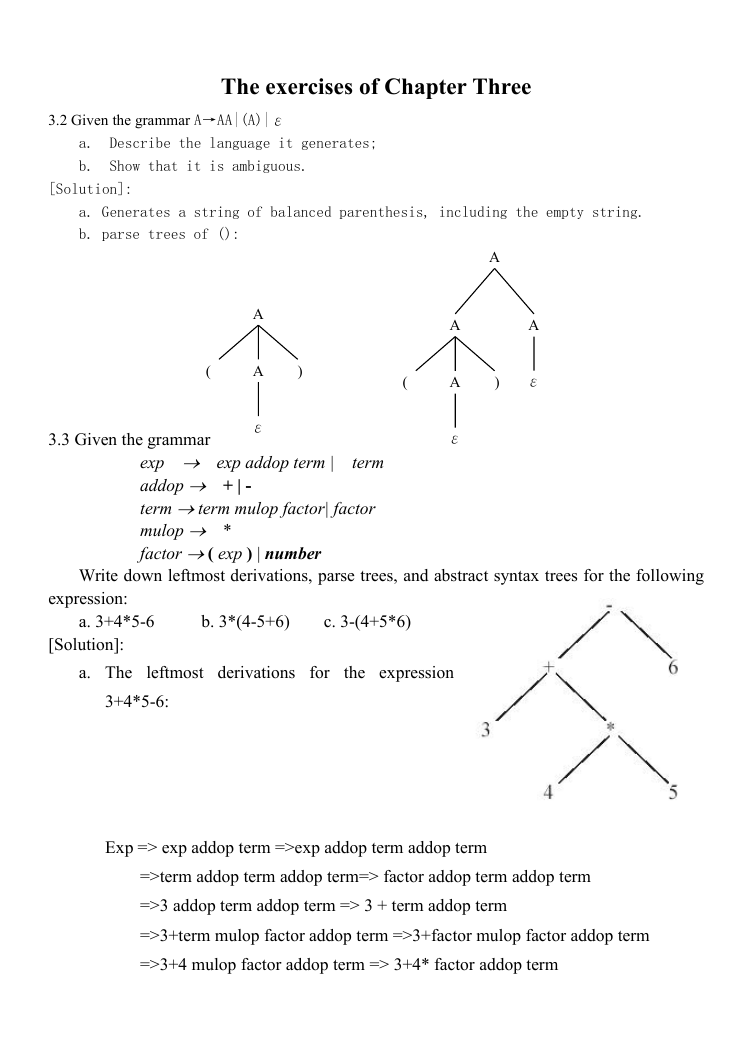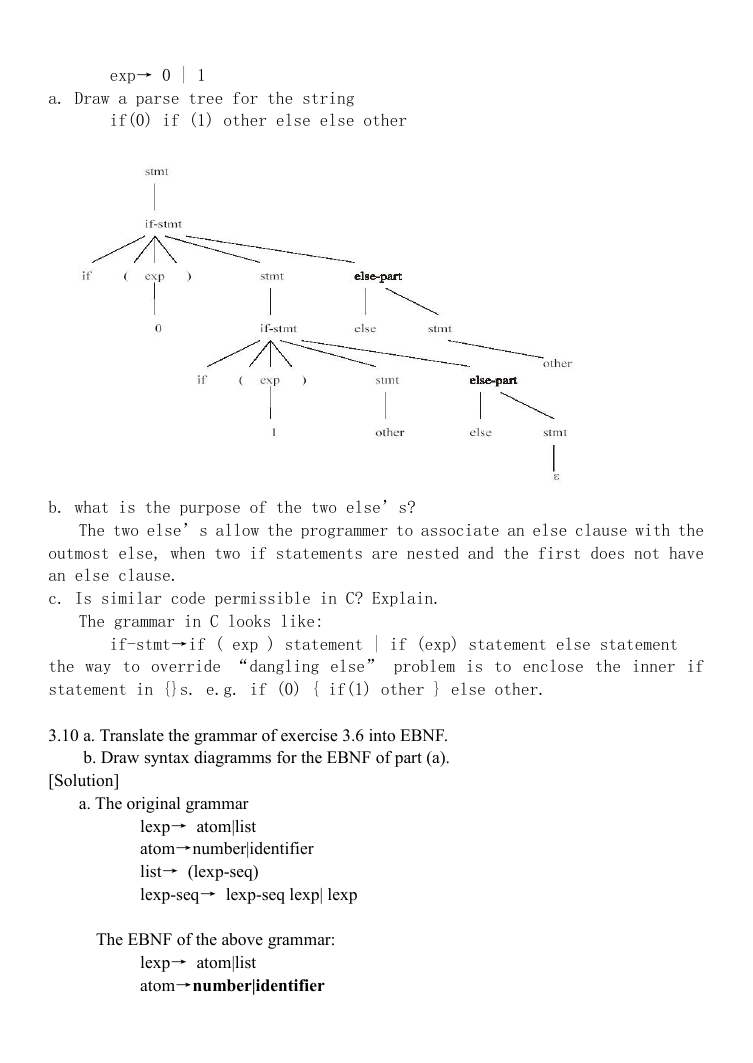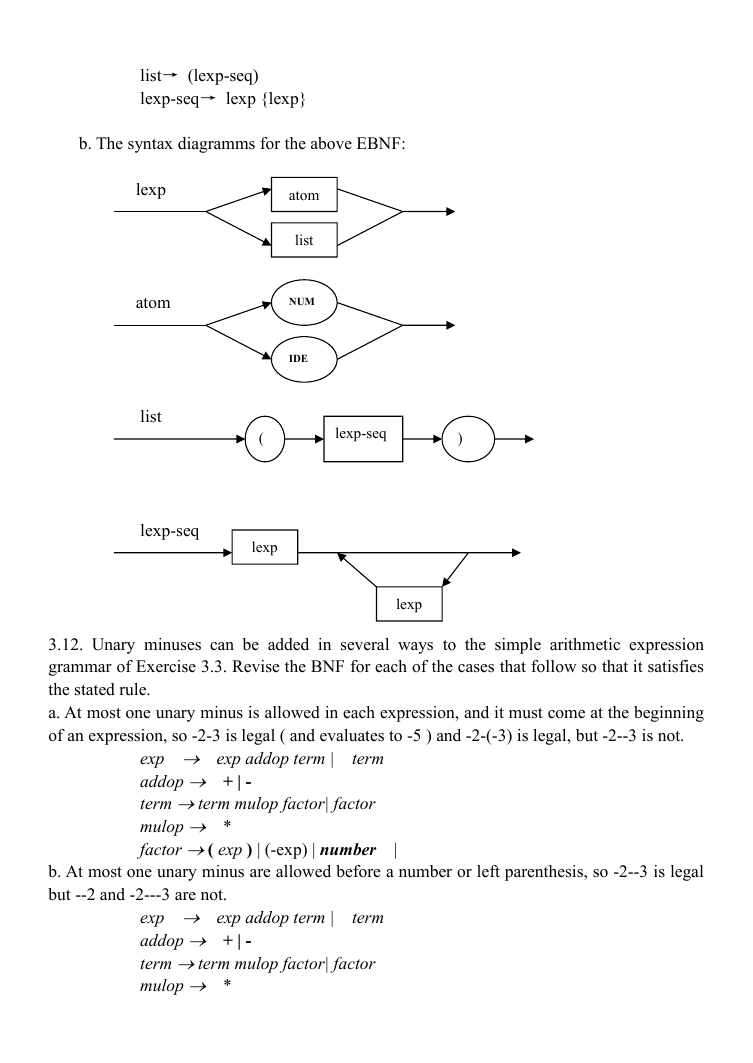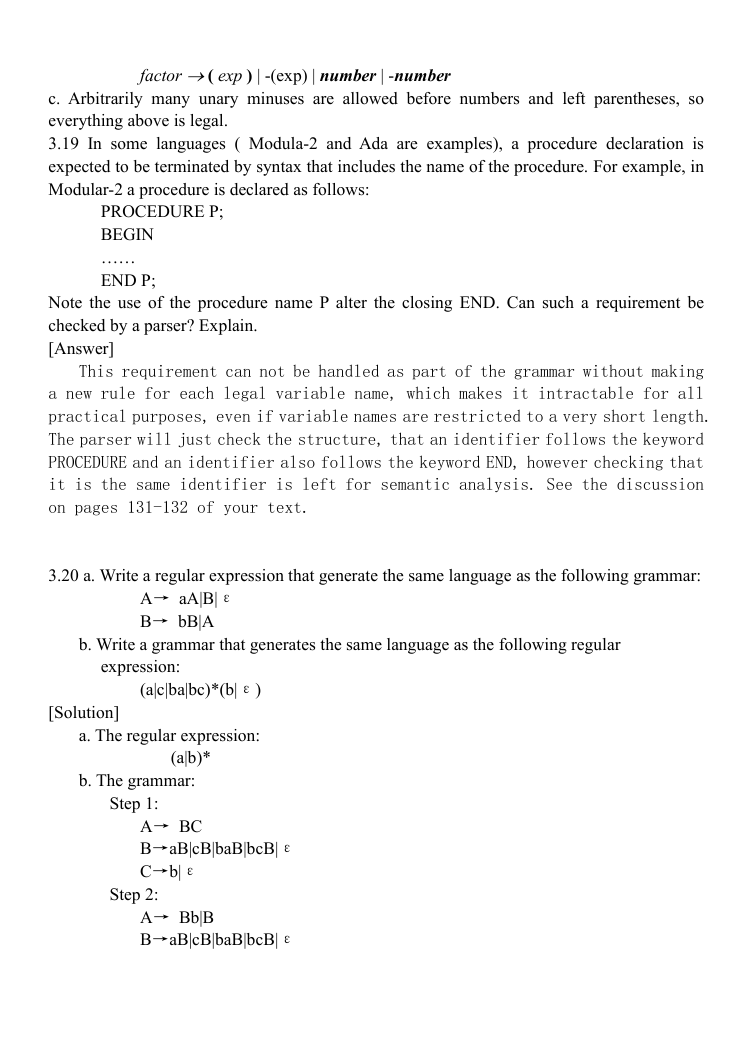The exercises of Chapter Three
3.2 Given the grammar A→AA|(A)|ε
a.
b.
Describe the language it generates;
Show that it is ambiguous.
[Solution]:
a. Generates a string of balanced parenthesis, including the empty string.
b. parse trees of ():
A
A
ε
)
(
(
3.3 Given the grammar
A
A
)
ε
A
A
ε
term
exp exp addop term |
addop + | -
term term mulop factor| factor
mulop *
factor ( exp ) | number
expression:
[Solution]:
Write down leftmost derivations, parse trees, and abstract syntax trees for the following
a. 3+4*5-6
b. 3*(4-5+6)
c. 3-(4+5*6)
a. The leftmost derivations
for
the expression
3+4*5-6:
Exp => exp addop term =>exp addop term addop term
=>term addop term addop term=> factor addop term addop term
=>3 addop term addop term => 3 + term addop term
=>3+term mulop factor addop term =>3+factor mulop factor addop term
=>3+4 mulop factor addop term => 3+4* factor addop term
�
=>3+4*5 addop term => 3+4*5-term=> 3+4*5-factor=>3+4*5-6
3.5 Write a grammar for Boolean expressions that includes the constants true and false, the
operators and, or and not, and parentheses. Be sure to give or a lower precedence than and
and and a lower precedence that not
and to allow repeated not’s, as in the Boolean
expression not not true. Also be sre your grammar is not ambiguous.
[solution]
bexp→bexp or A | A
A→ A and B | B
B→ not B | C
C→ (bexp) | true | false
Ex: not not true
boolExp → A
→ B
→ not B
→ not not B
→ not not C
→ not not true
3.8 Given the following grammar
statement→if-stmt | other | ε
if-stmt→ if ( exp ) statement else-part
else-part→ else statement | ε
�
exp→ 0 | 1
a. Draw a parse tree for the string
if(0) if (1) other else else other
b. what is the purpose of the two else’s?
The two else’s allow the programmer to associate an else clause with the
outmost else, when two if statements are nested and the first does not have
an else clause.
c. Is similar code permissible in C? Explain.
The grammar in C looks like:
if-stmt→if ( exp ) statement | if (exp) statement else statement
the way to override “dangling else” problem is to enclose the inner if
statement in {}s. e.g. if (0) { if(1) other } else other.
3.10 a. Translate the grammar of exercise 3.6 into EBNF.
b. Draw syntax diagramms for the EBNF of part (a).
[Solution]
a. The original grammar
lexp→ atom|list
atom→number|identifier
list→ (lexp-seq)
lexp-seq→ lexp-seq lexp| lexp
The EBNF of the above grammar:
lexp→ atom|list
atom→number|identifier
�
list→ (lexp-seq)
lexp-seq→ lexp {lexp}
b. The syntax diagramms for the above EBNF:
lexp
atom
list
atom
list
NUM
IDE
(
lexp-seq
)
lexp-seq
lexp
lexp
3.12. Unary minuses can be added in several ways to the simple arithmetic expression
grammar of Exercise 3.3. Revise the BNF for each of the cases that follow so that it satisfies
the stated rule.
a. At most one unary minus is allowed in each expression, and it must come at the beginning
of an expression, so -2-3 is legal ( and evaluates to -5 ) and -2-(-3) is legal, but -2--3 is not.
term
exp exp addop term |
addop + | -
term term mulop factor| factor
mulop *
factor ( exp ) | (-exp) | number
b. At most one unary minus are allowed before a number or left parenthesis, so -2--3 is legal
but --2 and -2---3 are not.
|
exp exp addop term |
addop + | -
term term mulop factor| factor
mulop *
term
�
factor ( exp ) | -(exp) | number | -number
c. Arbitrarily many unary minuses are allowed before numbers and left parentheses, so
everything above is legal.
3.19 In some languages ( Modula-2 and Ada are examples), a procedure declaration is
expected to be terminated by syntax that includes the name of the procedure. For example, in
Modular-2 a procedure is declared as follows:
PROCEDURE P;
BEGIN
……
END P;
Note the use of the procedure name P alter the closing END. Can such a requirement be
checked by a parser? Explain.
[Answer]
This requirement can not be handled as part of the grammar without making
a new rule for each legal variable name, which makes it intractable for all
practical purposes, even if variable names are restricted to a very short length.
The parser will just check the structure, that an identifier follows the keyword
PROCEDURE and an identifier also follows the keyword END, however checking that
it is the same identifier is left for semantic analysis. See the discussion
on pages 131-132 of your text.
3.20 a. Write a regular expression that generate the same language as the following grammar:
A→ aA|B|ε
B→ bB|A
b. Write a grammar that generates the same language as the following regular
[Solution]
expression:
(a|c|ba|bc)*(b|ε)
a. The regular expression:
(a|b)*
b. The grammar:
Step 1:
A→ BC
B→aB|cB|baB|bcB|ε
C→b|ε
A→ Bb|B
B→aB|cB|baB|bcB|ε
Step 2:
�










 2023年江西萍乡中考道德与法治真题及答案.doc
2023年江西萍乡中考道德与法治真题及答案.doc 2012年重庆南川中考生物真题及答案.doc
2012年重庆南川中考生物真题及答案.doc 2013年江西师范大学地理学综合及文艺理论基础考研真题.doc
2013年江西师范大学地理学综合及文艺理论基础考研真题.doc 2020年四川甘孜小升初语文真题及答案I卷.doc
2020年四川甘孜小升初语文真题及答案I卷.doc 2020年注册岩土工程师专业基础考试真题及答案.doc
2020年注册岩土工程师专业基础考试真题及答案.doc 2023-2024学年福建省厦门市九年级上学期数学月考试题及答案.doc
2023-2024学年福建省厦门市九年级上学期数学月考试题及答案.doc 2021-2022学年辽宁省沈阳市大东区九年级上学期语文期末试题及答案.doc
2021-2022学年辽宁省沈阳市大东区九年级上学期语文期末试题及答案.doc 2022-2023学年北京东城区初三第一学期物理期末试卷及答案.doc
2022-2023学年北京东城区初三第一学期物理期末试卷及答案.doc 2018上半年江西教师资格初中地理学科知识与教学能力真题及答案.doc
2018上半年江西教师资格初中地理学科知识与教学能力真题及答案.doc 2012年河北国家公务员申论考试真题及答案-省级.doc
2012年河北国家公务员申论考试真题及答案-省级.doc 2020-2021学年江苏省扬州市江都区邵樊片九年级上学期数学第一次质量检测试题及答案.doc
2020-2021学年江苏省扬州市江都区邵樊片九年级上学期数学第一次质量检测试题及答案.doc 2022下半年黑龙江教师资格证中学综合素质真题及答案.doc
2022下半年黑龙江教师资格证中学综合素质真题及答案.doc